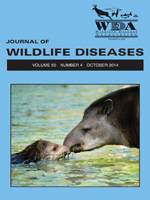Parasites play a major role in ecosystems, and understanding of host–parasite interactions is important for predicting parasite transmission dynamics and epidemiology. However, there is still a lack of knowledge about the distribution, diversity, and impact of parasites in wildlife, especially from remote areas. Hepatozoon is a genus of apicomplexan parasites that is transmitted by ingestion of infected arthropod vectors. However, alternative modes of transmission have been identified such as trophic transmission. Using the 18S rRNA gene as a marker, we provide an assessment of Hepatozoon prevalence in six wild canid and two rodent species collected between 2003 and 2012 from remote areas in North Africa. By combining this with other predator–prey systems in a phylogenetic framework, we investigate Hepatozoon transmission dynamics in distinct host taxa. Prevalence was high overall among host species (African jerboa Jaculus jaculus [17/47, 36%], greater Egyptian jerboa Jaculus orientalis [5/7, 71%], side-striped jackal Canis adustus [1/2, 50%], golden jackal Canis aureus [6/32, 18%], pale fox Vulpes pallida [14/28, 50%], Rüppell's fox Vulpes rueppellii [6/11, 55%], red fox Vulpes vulpes [8/16, 50%], and fennec fox Vulpes zerda [7/11, 42%]). Phylogenetic analysis showed further evidence of occasional transmission of Hepatozoon lineages from prey to canid predators, which seems to occur less frequently than in other predator–prey systems such as between snakes and lizards. Due to the complex nature of the Hepatozoon lifecycle (heteroxenous and vector-borne), future studies on these wild host species need to clarify the dynamics of alternative modes of Hepatozoon transmission and identify reservoir and definitive hosts in natural populations. We also detected putative Babesia spp. (Apicomplexa: Piroplasmida) infections in two canid species from this region, V. pallida (1/28) and V. zerda (1/11).
How to translate text using browser tools
1 October 2014
MOLECULAR ASSESSMENT OF HEPATOZOON (APICOMPLEXA: ADELEORINA) INFECTIONS IN WILD CANIDS AND RODENTS FROM NORTH AFRICA, WITH IMPLICATIONS FOR TRANSMISSION DYNAMICS ACROSS TAXONOMIC GROUPS
João P. Maia,
Francisco Álvares,
Zbyszek Boratyński,
José C. Brito,
João V. Leite,
D. James Harris
ACCESS THE FULL ARTICLE

Journal of Wildlife Diseases
Vol. 50 • No. 4
October 2014
Vol. 50 • No. 4
October 2014




